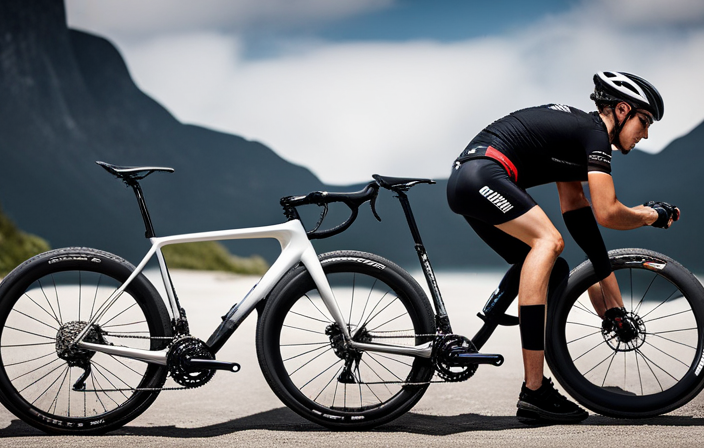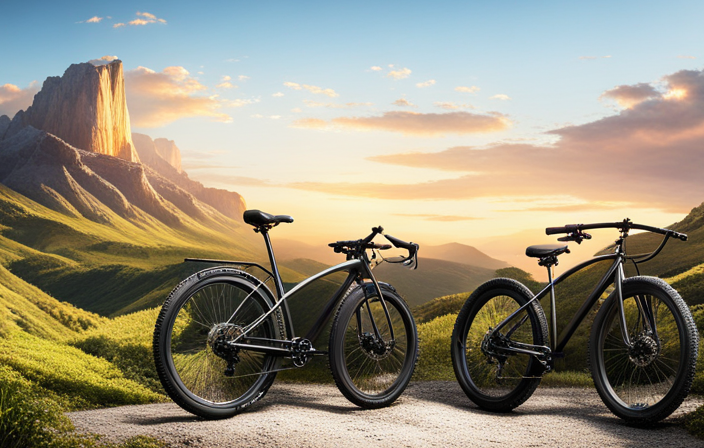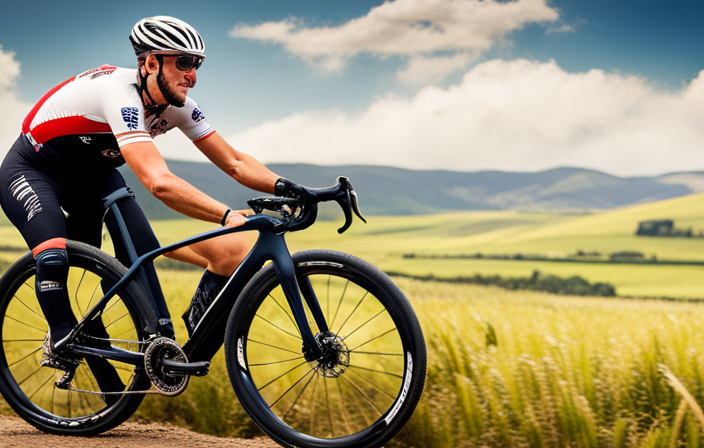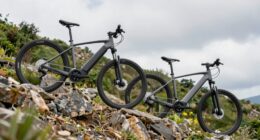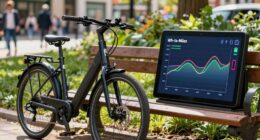Are you looking to buy a new Niner gravel bike but are unsure about what size frame to get? Selecting the correct frame size is essential for a pleasant and effective riding experience. In this article, I will help you figure out the perfect frame size by taking into account aspects like inseam length, body proportions, and budget.
By following these steps, you’ll be well-equipped to make an informed decision and enjoy your new Niner gravel bike to the fullest.
Key Takeaways
- Choosing the right frame size is important for a comfortable and efficient riding experience, reducing the risk of injury, enhancing overall performance, and providing optimal riding position.
- Inseam measurement is a helpful tool to determine frame size, as it helps identify the frame with proper leg extension, provides standover clearance, and can be measured at home or by professional fitting services.
- Consulting Niner’s size chart is beneficial, as it provides a range of frame sizes based on height and inseam length, along with information on frame geometry, reach, stack, and optimal saddle height, helping choose a frame that suits riding style and preferences.
- Considering body proportions, such as height, inseam length, arm length, and torso length, is crucial in selecting the right frame size, as it influences top tube length, standover clearance, reach to handlebars, riding position, and stability. Seeking professional bike fitting services can provide expert analysis, adjustments, and recommendations for the ideal frame size and suitable saddle for individual anatomy and preferences.
Importance of Choosing the Right Frame Size
You should make sure to choose the right frame size for your Niner gravel bike, as it is crucial for a comfortable and efficient riding experience.
The importance of selecting the correct frame size cannot be emphasized enough. A properly fitting bike ensures that you are in an optimal riding position, reducing the risk of injury and enhancing your overall performance.
To determine the appropriate frame size, one key factor to consider is your inseam measurement. This measurement refers to the length from your crotch to the floor while wearing cycling shoes. Knowing this measurement will help you identify a frame size that provides adequate standover clearance and allows for proper leg extension while pedaling.
While it is possible to measure your inseam at home using a tape measure, seeking professional fitting services can provide even more accurate results. Professional fitters have specialized tools and expertise to assess your body proportions, flexibility, and unique riding style. They can recommend precise adjustments or suggest alternative frame sizes based on their analysis.
In conclusion, choosing the right frame size for your Niner gravel bike is essential for a comfortable and efficient ride. To ensure accuracy, consider measuring your inseam length or consulting with professional fitting services. Taking these steps will help you find a frame that perfectly suits your body geometry and guarantees an enjoyable cycling experience.
Measure Your Inseam Length
To determine the appropriate frame size for a Niner gravel bike, start by measuring your inseam length. Choosing the correct bike frame size is crucial for ensuring a comfortable and efficient riding experience. The inseam measurement is taken from the inside of your leg, starting from the crotch to the floor. This measurement helps determine how much standover clearance you will have when straddling the bike.
Measuring your inseam for bike frame size is a straightforward process that can be done at home with a tape measure and a sturdy book or wall. Begin by standing barefoot against a wall with your feet shoulder-width apart. Place the book or object between your legs, snug against your crotch, making sure it is parallel to the floor. Measure from the top of the book or object to the floor in centimeters or inches.
By knowing your inseam length, you can consult Niner’s size chart to find out which frame size best suits you based on their recommendations. This will ensure that you choose a frame that provides optimal comfort and handling for your specific body measurements and riding style.
Consult Niner’s Size Chart
Consulting Niner’s size chart will help determine the appropriate frame size for your Niner gravel bike. It is important to measure your frame accurately to ensure a comfortable and efficient riding experience. Here are some key points to consider when using the size chart:
-
Frame Size: The size chart will provide a range of frame sizes based on your height and inseam length. This will give you an idea of which size would be the best fit for you.
-
Geometry: Niner’s size chart also includes information about the geometry of each frame size, such as top tube length and standover height. Understanding these measurements can help you choose a frame that suits your riding style and preferences.
-
Reach and Stack: These measurements indicate how long and how tall the bike will feel when you’re riding it. They can give you an idea of whether a particular frame size will provide a comfortable riding position.
-
Saddle Height: The size chart may also suggest an optimal saddle height based on your inseam length. This can be helpful in setting up your bike correctly.
Once you have determined which frame sizes might work for you, it’s a good idea to test ride different sizes to see how they feel on the road or trail. This hands-on experience will give you a better understanding of which frame size is most suitable for your needs.
Test Ride Different Sizes
Consider taking the opportunity to test ride various sizes to determine which one feels most comfortable for your riding style and preferences. A test ride experience can provide valuable insights into how different frame sizes affect your overall comfort and performance on the bike. By comparing different sizes, you can find the perfect fit that will enhance your riding experience.
To help you visualize the differences between frame sizes, here is a table that compares three common Niner gravel bike frame sizes:
| Frame Size | Rider Height Range | Top Tube Length (mm) |
|---|---|---|
| Small | 5’2" – 5’6" | 530 |
| Medium | 5’6" – 5’10" | 550 |
| Large | 5’10" – 6’2" | 570 |
During your test rides, pay attention to how each size feels when you’re in a riding position. Does one size feel more natural and comfortable? Are there any noticeable differences in handling or stability? These are important factors to consider when choosing the right frame size for your Niner gravel bike.
With this understanding of how different sizes can impact your test ride experience, let’s now transition into considering your body proportions as another crucial aspect in determining the ideal frame size for you.
Consider Your Body Proportions
Taking into account your body proportions is essential when determining the ideal fit for your Niner gravel bike. Proper bike frame sizing based on your body measurements ensures a comfortable and efficient riding experience. Here are four key factors to consider:
-
Height: Your height plays a crucial role in choosing the right frame size. Taller individuals generally require larger frames, while shorter riders need smaller ones to maintain proper reach and leg extension.
-
Inseam Length: Measuring your inseam length helps determine the correct top tube length and standover clearance. It ensures that you can straddle the bike comfortably while maintaining proper pedal stroke.
-
Arm Length: Your arm length affects how far you can comfortably reach the handlebars without straining your back or shoulders. Consider this measurement when selecting a frame with an appropriate top tube length and stem size.
-
Torso Length: The length of your torso influences your riding position, especially in relation to the handlebars and saddle height. A frame that accommodates your torso length will provide optimal comfort and stability.
By considering these body proportions during bike frame sizing, you can find a Niner gravel bike that fits you perfectly, allowing for an enjoyable ride every time.
To further ensure an ideal fit, it’s advisable to seek professional bike fitting services where experts can fine-tune the adjustments based on your unique body characteristics and riding preferences.
Seek Professional Bike Fitting Services
After considering your body proportions, it’s essential to seek professional bike fitting services to ensure that you find the perfect size for your Niner gravel bike frame.
A bike fit analysis conducted by a trained professional can provide valuable insights into your specific needs and help determine the ideal frame size for you.
During a bike fit analysis, various factors such as your body measurements, flexibility, and riding style will be taken into account. The fitting expert will assess your position on the bike, making necessary adjustments to optimize comfort and performance. This includes finding the right saddle that suits your anatomy and riding preferences.
Finding the right saddle is crucial as it directly impacts comfort during long rides. A professional bike fitter will consider factors like sit bone width, pelvic rotation, and pressure points to recommend a saddle that provides optimal support and minimizes discomfort.
By seeking professional bike fitting services, you can ensure that you choose a Niner gravel bike frame size that perfectly suits your body proportions and riding style. This personalized approach will enhance your overall cycling experience and prevent any potential injuries or discomfort in the future.
Now let’s delve into another important aspect of choosing the right frame size – considering your future riding goals.
Consider Your Future Riding Goals
To ensure a satisfying cycling experience in the long run, it’s important to think about your future riding goals before making a decision on which Niner gravel bike frame to choose. Considering your future riding goals will help you select a frame that can accommodate your needs as you progress in your cycling journey. Here are three things to consider:
-
Future Bikepacking Adventures: If you have plans of embarking on bikepacking adventures in the future, it’s crucial to choose a frame that can handle the demands of off-road terrain and carry the necessary gear. Look for a gravel bike frame with ample tire clearance and mounting points for racks and bags.
-
Long Distance Endurance Rides: If you envision yourself tackling long distance endurance rides, prioritize comfort and efficiency. Consider a gravel bike frame with relaxed geometry that allows for an upright riding position, reducing strain on your back and neck during those extended hours on the saddle.
-
Suspension Fork Compatibility: When thinking about your future riding goals, don’t forget to take into account suspension fork compatibility. If you plan on venturing into rougher terrains or encountering more technical trails, having the option to upgrade to a suspension fork can greatly enhance your riding experience.
By considering these factors, you’ll be able to make an informed decision when choosing the right Niner gravel bike frame for your needs.
Now let’s delve into how suspension fork compatibility should also be taken into account when selecting your ideal frame size.
Take Into Account Suspension Fork Compatibility
Consider whether you want the option to upgrade to a suspension fork when selecting your ideal Niner gravel bike. A suspension fork can greatly enhance your riding experience by absorbing bumps and vibrations, providing a smoother and more comfortable ride. However, it’s important to understand that suspension forks require regular maintenance to function properly.
This includes cleaning and lubricating the seals, checking for any leaks or damage, and adjusting the air pressure or spring preload as needed. Additionally, setting up a suspension fork correctly is crucial for optimal performance. This involves adjusting the sag (the amount of travel used when sitting on the bike), rebound damping (how quickly the fork returns after compressing), and compression damping (how much resistance there is when compressing).
Taking all these factors into account, it’s essential to choose a Niner gravel bike frame that is compatible with a suspension fork if you anticipate wanting this feature in the future.
Now let’s move on to considering frame material and weight…
Consider Frame Material and Weight
When choosing a Niner gravel bike, it’s important to think about the material and weight of the frame. The frame material comparison is crucial because it directly affects the overall performance and durability of the bike. Niner offers frames made from various materials such as aluminum, carbon fiber, and steel.
Aluminum frames are lightweight and provide a responsive ride, while carbon fiber frames offer excellent stiffness and vibration damping. Steel frames, on the other hand, are known for their durability and smoothness.
Weight distribution analysis is another aspect to consider when selecting a gravel bike frame. A well-balanced weight distribution ensures stability and control over rough terrains. It’s essential to find a frame that distributes weight evenly between the front and rear wheels for optimal handling.
When evaluating geometry and handling characteristics, you should take into account how different frame materials impact these factors. Carbon fiber frames often have more aggressive geometries that allow for nimble handling on technical terrain. Aluminum frames may offer a more comfortable upright position suitable for longer rides.
Considering both frame material and weight distribution will help you choose the right size Niner gravel bike frame that suits your riding style and preferences without compromising on performance or comfort.
Evaluate Geometry and Handling Characteristics
Evaluating the geometry and handling characteristics of different gravel bikes is essential in finding the right fit for your riding style. When it comes to bike frame sizing, it’s important to consider how the geometry of a particular frame will affect its handling performance.
The geometry refers to the angles and dimensions of the frame, which can greatly impact how the bike feels and responds on various terrains. One key aspect to look at is the head tube angle. A steeper head tube angle will result in quicker steering response, making the bike feel more nimble and agile. On the other hand, a slacker head tube angle provides more stability at higher speeds but may sacrifice some maneuverability.
Another factor to consider is the bottom bracket drop. A lower bottom bracket drop improves stability by lowering your center of gravity, especially when cornering or descending steep sections. However, this may also increase the chances of pedal strikes on rough terrain.
Additionally, evaluating factors like wheelbase length, chainstay length, and fork rake can provide insights into how a bike will handle different situations. It’s important to find a balance between stability and agility that suits your preferences.
Considering tire clearance and wheel size options is another crucial step in finding your ideal gravel bike frame size without compromising performance or comfort.
Consider Tire Clearance and Wheel Size Options
To find the right fit for your riding style, think about tire clearance and which wheel size options would suit you best.
When it comes to gravel bikes, tire clearance is crucial as it determines the width of tires you can use. The wider the tires, the more stable and comfortable your ride will be on rough terrain. Niner gravel bikes offer various tire clearance options, allowing you to choose between different widths based on your preferences and riding conditions.
In addition to tire clearance, considering the wheel size options is important. Niner offers gravel bikes with both 700c and 650b wheel sizes. The 700c wheels are more common and provide faster rolling speed on smoother surfaces like roads or hard-packed gravel. On the other hand, 650b wheels offer better traction and stability on rougher terrain due to their larger diameter.
When deciding between wheel sizes, take into account the type of terrain you’ll be riding on most frequently. If you’ll primarily ride on smooth surfaces or want a faster ride, go for 700c wheels. However, if you plan on tackling more challenging off-road trails or desire extra stability, consider opting for 650b wheels.
Now that we’ve covered tire clearance and wheel size options, let’s move onto seeking recommendations and reviews from experienced riders who have already tested out Niner gravel bikes without compromising performance or comfort.
Seek Recommendations and Reviews
When it comes to seeking recommendations and reviews for buying a niner gravel bike frame, I find that reading online bike reviews and forums is incredibly helpful. These platforms provide valuable insights from experienced cyclists who have already tested various frames and can offer firsthand advice on their performance.
Additionally, asking for recommendations from seasoned riders in my cycling community has proven to be invaluable, as they can share their personal experiences and offer tailored suggestions based on my specific needs and preferences.
Read Online Bike Reviews and Forums
I’ve found that reading online bike reviews and forums can be helpful in determining the right size Niner gravel bike frame to buy. Here are three reasons why:
-
Bike brand comparisons: Online reviews allow you to compare different bike brands and their respective frame sizes. This gives you a better understanding of how Niner frames measure up against other popular brands, helping you make an informed decision.
-
Tips for choosing the right frame size: Bike enthusiasts often share valuable tips and insights on forums about selecting the correct frame size. They discuss factors like inseam measurements, riding style, and body proportions, which can greatly influence your choice.
-
Detailed information: Online reviews provide detailed information about specific Niner gravel bike models, including their geometry and sizing recommendations from the manufacturer. This data allows you to analyze how each frame size will fit your body type and riding preferences.
By exploring online reviews and forums, you gain valuable knowledge that helps narrow down your options when choosing the perfect Niner gravel bike frame size.
Now let’s move on to asking for recommendations from experienced cyclists as another useful step in this process.
Ask for Recommendations from Experienced Cyclists
One way to gather valuable insights is by asking experienced cyclists for their recommendations. When it comes to choosing the right size Niner gravel bike frame, experienced cyclists can provide valuable advice based on their own experiences and knowledge.
They can recommend the ideal frame size based on your height, riding style, and preferences. Additionally, they can also offer insights into different bike frame materials and their benefits. For example, some cyclists may prefer carbon frames for their lightweight and responsive nature, while others may opt for steel frames for their durability and smooth ride quality.
Weight is another important factor to consider when choosing a bike frame as it can affect the overall performance of the bike. By consulting with experienced cyclists, you can gain valuable information about different bike frame materials and weight considerations that will help you make an informed decision.
When considering budget and available options…
Consider Budget and Available Options
Consider your budget and the available options when deciding what size Niner gravel bike frame to buy. It is important to take into account your budget constraints, as well as the different frame sizes that are available.
When it comes to budget, it’s crucial to determine how much you are willing to spend on a gravel bike frame. This will help narrow down your options and ensure that you stay within your financial limits. Additionally, consider any additional costs such as accessories or maintenance.
Next, take a look at the available frame sizes for Niner gravel bikes. It is essential to choose a size that fits you properly and provides a comfortable riding experience. Keep in mind that different manufacturers may have slightly different sizing charts, so it’s worth trying out different sizes if possible.
To evoke emotion in the audience, here are three key points:
- A carefully chosen gravel bike frame size can enhance your riding experience and prevent discomfort.
- Investing in a quality frame within your budget will provide long-term value.
- Making an informed decision based on both cost and fit will lead to greater satisfaction with your purchase.
Considering these factors will help you make a final decision on what size Niner gravel bike frame to buy without compromising comfort or breaking the bank.
Make a Final Decision
When making a final decision on which size niner gravel bike frame to buy, it’s important to weigh all factors and consider your gut feeling.
Take into account your body measurements, riding style, and intended use of the bike.
Additionally, consulting with local bike shop experts can provide valuable insights and recommendations based on their expertise and experience.
Ultimately, by carefully considering all these factors and seeking expert advice, you can make an informed decision that ensures a comfortable and enjoyable riding experience.
Weigh All Factors and Consider Your Gut Feeling
Take into account all factors and trust your gut when deciding what size Niner gravel bike frame to purchase. To make an informed decision, consider measuring your inseam accurately and consulting the size chart provided by Niner.
Here are four key points to weigh in on:
-
Riding Style: Determine if you prefer a more aggressive or relaxed riding position, as this will affect the frame size you choose.
-
Terrain: Consider the type of terrain you’ll be riding on most frequently, as different frame sizes excel in different conditions.
-
Comfort: Take into account your own comfort preferences, such as whether you prefer a slightly larger or smaller frame for a better fit.
-
Future Adjustments: If you plan on making significant adjustments to your bike setup, factor that into your decision-making process.
After considering these factors, consult with local bike shop experts who can provide additional guidance based on their expertise and experience.
Consult with Local Bike Shop Experts
For expert advice and guidance, it’s worth consulting with the knowledgeable staff at your local bike shop. They have years of experience and can provide valuable insights when it comes to choosing the right size Niner gravel bike frame for you.
Bike shop experts understand the importance of a proper fit and will take into account factors such as your height, inseam length, riding style, and personal preferences. They may even recommend test rides or adjustments to ensure you find the perfect fit.
Local bike shop recommendations are especially useful because they are familiar with the terrain in your area and can suggest frame sizes that work well for local conditions.
So, before making a decision, visit your local bike shop and benefit from their expertise. With their help, you’ll be well on your way to enjoying your new Niner gravel bike!
Enjoy Your New Niner Gravel Bike!
Congratulations on your new Niner gravel bike! You’ve made an excellent choice for exploring off-road trails and enjoying the thrill of gravel riding.
To ensure that you have a great experience with your new bike, here are some important tips to keep in mind:
-
Bike fit: One of the most crucial aspects of enjoying your new Niner gravel bike is getting the right fit. Make sure to adjust the saddle height, handlebar position, and reach to ensure optimal comfort and efficiency while riding.
-
Maintenance tips: Regular maintenance is essential to keep your bike running smoothly. Remember to clean and lubricate the chain regularly, check tire pressure before every ride, inspect brake pads for wear, and keep an eye on any signs of wear or damage.
-
Explore different terrains: Your Niner gravel bike is designed to handle various terrains, from smooth roads to challenging off-road trails. Take advantage of its versatility by exploring different routes and pushing yourself outside of your comfort zone.
-
Join a community: Gravel biking has gained popularity in recent years, so why not join a local cycling group or participate in organized rides? It’s a great way to meet like-minded riders, learn from experienced cyclists, and discover new routes in your area.
Enjoy every moment with your new Niner gravel bike! With proper bike fit and regular maintenance, you’ll be ready for countless adventures on two wheels.
Frequently Asked Questions
Can I use a suspension fork with a Niner gravel bike frame?
Yes, you can use a suspension fork with a Niner gravel bike frame. The suspension fork compatibility allows for enhanced off-road performance and increased comfort on rough terrain. It absorbs impacts, reducing vibrations and minimizing fatigue during long rides.
This setup provides better control and traction, especially when encountering bumps and obstacles. Additionally, having a gravel bike frame with suspension fork gives you the freedom to explore various terrains without compromising ride quality or handling.
What are the different frame materials available for Niner gravel bikes?
When it comes to frame materials for Niner gravel bikes, there are a few options to consider.
Aluminum frames offer durability and affordability, but they can be slightly heavier.
On the other hand, carbon fiber frames are lightweight and provide excellent vibration damping, but they tend to be more expensive.
Titanium frames strike a balance between the two, offering strength and comfort with a higher price tag.
Ultimately, the choice depends on your budget and priorities.
Pros and cons aside, finding the perfect frame material is like finding a reliable companion for your cycling adventures—it should match your style and enhance your overall experience.
How do I evaluate the geometry and handling characteristics of a Niner gravel bike frame?
To evaluate the geometry and handling characteristics of a Niner gravel bike frame, there are a few key factors to consider.
Firstly, look at the head tube angle and fork offset to gauge how stable or nimble the bike will feel.
Additionally, examine the chainstay length for responsiveness and the bottom bracket height for stability.
These factors, along with other design elements like wheelbase and stack-reach measurements, play a crucial role in determining optimal frame size and evaluating ride quality.
What should I consider when it comes to tire clearance and wheel size options?
When it comes to tire clearance considerations and wheel size options, there are a few key things to keep in mind.
Imagine you’re driving on a bumpy road with potholes. A larger wheel can roll over these obstacles more easily, providing a smoother ride.
Additionally, tire clearance is crucial for off-road adventures as it determines the maximum tire width your bike can accommodate.
So, consider your riding preferences and terrain to determine the ideal wheel size and tire clearance for your Niner gravel bike frame.
Are there any specific recommendations or reviews for Niner gravel bike frames?
When it comes to the best gravel bike frames for off-road adventures, Niner offers several options worth considering.
Comparing the durability and performance of different Niner gravel bike frames is essential in making an informed decision. Look for features like a sturdy frame construction, ample tire clearance, and compatibility with various wheel sizes.
Additionally, consider customer reviews to gauge overall satisfaction and performance on rough terrains.
Conclusion
As I stood there, holding my brand new Niner gravel bike, a feeling of excitement and adventure washed over me. This sleek machine symbolized endless possibilities and the freedom to explore uncharted territories.
With the right frame size carefully chosen, I knew this bike would become an extension of myself, allowing me to conquer any terrain with ease.
So, whether you’re a seasoned cyclist or just starting out, remember the importance of finding the perfect fit for your Niner gravel bike.
Let the journey begin!


